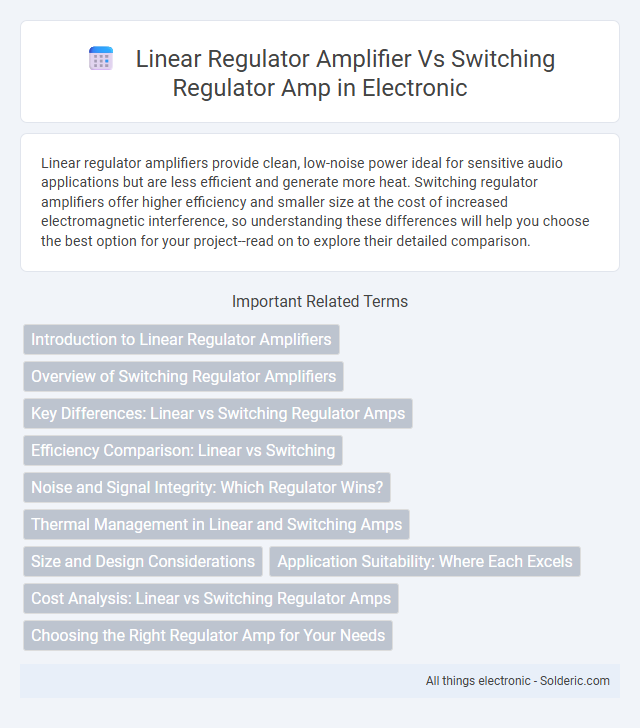Linear regulator amplifiers provide clean, low-noise power ideal for sensitive audio applications but are less efficient and generate more heat. Switching regulator amplifiers offer higher efficiency and smaller size at the cost of increased electromagnetic interference, so understanding these differences will help you choose the best option for your project--read on to explore their detailed comparison.
Comparison Table
| Feature | Linear Regulator Amplifier | Switching Regulator Amplifier |
|---|---|---|
| Efficiency | Low (typically 40-60%) | High (typically 80-95%) |
| Heat Dissipation | High heat generation due to voltage drop | Low heat generation, more energy efficient |
| Complexity | Simple design, fewer components | Complex design, includes inductors and switching elements |
| Noise and Ripple | Low noise, clean output voltage | Higher noise and ripple due to switching |
| Size | Compact, small footprint | Larger size due to inductors and filters |
| Cost | Lower cost, less expensive components | Higher cost due to complex components |
| Application | Audio amplifiers, low noise sensitive circuits | High power applications, battery-powered devices |
Introduction to Linear Regulator Amplifiers
Linear regulator amplifiers provide precise voltage control by continuously adjusting resistance to maintain a stable output voltage, making them ideal for low-noise and sensitive audio applications. Their simple design offers fast transient response and minimal electromagnetic interference, enhancing audio clarity in your amplifier system. However, they are less efficient than switching regulator amplifiers, as excess voltage is dissipated as heat.
Overview of Switching Regulator Amplifiers
Switching regulator amplifiers use high-frequency switching components to efficiently convert power with minimal heat dissipation, enabling compact designs and longer battery life. These amplifiers maintain voltage regulation by rapidly switching between on and off states, which reduces energy loss compared to linear regulators that dissipate excess voltage as heat. Due to their high efficiency and ability to handle varying load conditions, switching regulator amplifiers are commonly employed in portable electronics and high-power applications.
Key Differences: Linear vs Switching Regulator Amps
Linear regulator amplifiers provide clean, low-noise power with simple design but are less efficient, dissipating excess voltage as heat. Switching regulator amplifiers achieve high efficiency by rapidly switching components on and off, converting voltage with minimal energy loss, but introduce switching noise and require complex filtering. Key differences include linear amps' superior noise performance and simpler implementation versus switching amps' efficiency and compact thermal management.
Efficiency Comparison: Linear vs Switching
Switching regulator amplifiers typically achieve efficiency rates between 80% to 95%, significantly outperforming linear regulator amplifiers, which often range from 30% to 60%. This efficiency difference arises because switching regulators convert power by rapidly switching elements on and off, minimizing energy loss as heat, whereas linear regulators dissipate excess voltage as heat, leading to lower efficiency. Your choice depends on whether you prioritize energy conservation and thermal management (favoring switching regulators) or require simpler design and lower noise (favoring linear regulators).
Noise and Signal Integrity: Which Regulator Wins?
Linear regulator amplifiers excel in noise reduction due to their simple design, producing minimal output ripple and preserving signal integrity, making them ideal for sensitive analog applications. Switching regulator amplifiers generate higher electromagnetic interference (EMI) and ripple noise from rapid switching actions, which can degrade signal quality unless extensive filtering is applied. Your choice depends on whether low noise or high efficiency is more critical for your specific amplifier application.
Thermal Management in Linear and Switching Amps
Thermal management in linear regulator amplifiers is critical due to their continuous power dissipation, often requiring large heat sinks to maintain safe operating temperatures and prevent thermal shutdown. Switching regulator amplifiers generate less heat because they operate with higher efficiency, typically above 80-90%, reducing the need for extensive cooling solutions and allowing for more compact designs. To optimize your system's reliability and performance, selecting the appropriate amplifier type based on thermal constraints is essential.
Size and Design Considerations
Linear regulator amplifiers are typically smaller and simpler in design due to fewer external components and straightforward circuitry, making them ideal for space-constrained applications. Switching regulator amplifiers require larger PCB areas to accommodate inductors, capacitors, and diodes, resulting in more complex layouts and increased electromagnetic interference considerations. Design challenges for switching regulators include managing noise and ensuring proper thermal dissipation, while linear regulators offer ease of integration with compact, low-noise designs.
Application Suitability: Where Each Excels
Linear regulator amplifiers excel in applications requiring low noise and stable voltage output, such as audio equipment and sensitive analog circuits, due to their simple design and minimal electromagnetic interference. Switching regulator amplifiers are ideal for battery-powered devices and high-efficiency systems like portable electronics and power supplies, where energy conservation and heat dissipation are critical. Your choice depends on whether precision and low noise or efficiency and power handling are the primary goals of your application.
Cost Analysis: Linear vs Switching Regulator Amps
Linear regulator amplifiers generally incur higher operational costs due to significant power dissipation through heat, requiring larger heat sinks and cooling solutions. Switching regulator amplifiers offer greater cost efficiency over time by minimizing energy loss and reducing thermal management expenses despite a higher initial component cost. The total cost analysis favors switching regulators in applications demanding high efficiency and power scalability.
Choosing the Right Regulator Amp for Your Needs
Linear regulator amplifiers offer low noise and simple design, making them ideal for applications requiring clean power and minimal electromagnetic interference. Switching regulator amplifiers provide higher efficiency and better heat management, suitable for battery-powered devices or systems with limited space. Your choice depends on whether you prioritize low noise performance or energy efficiency for your specific electronic design.
Linear regulator amplifier vs Switching regulator amp Infographic

 solderic.com
solderic.com